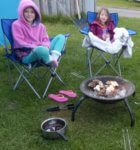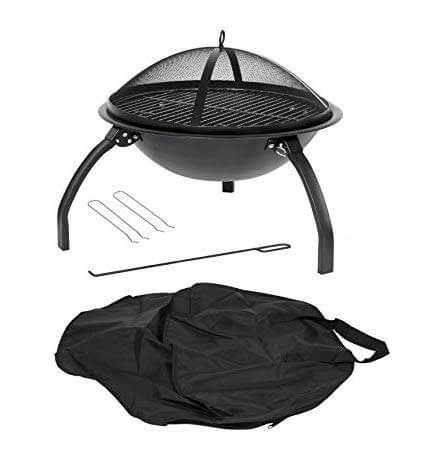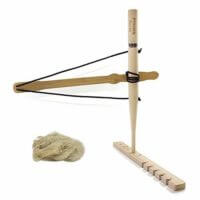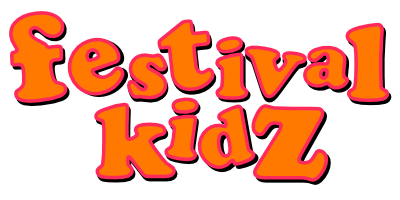 There’s something wonderful about building a proper wood fire with your children, and one of the highlights of our family festival time is always fireside cooking. It is also a great way to keep children warm and occupied in the evenings!
There’s something wonderful about building a proper wood fire with your children, and one of the highlights of our family festival time is always fireside cooking. It is also a great way to keep children warm and occupied in the evenings!
If you have never cooked on a fire before, I am writing a few posts about the equipment needed, how to build and light a fire, and simple things you can cook on it.
Make sure you check whether the festival allows fire pits first!
Equipment
Fire Pit
I spent a lot of time looking at fire pits before I bought our one, and we love it. In fact we bought two, one for festivals and one we use at home! It can burn both charcoal or wood and has a BBQ grill for cooking. This makes it my favourite bit of festival kit.
 Read my full review of the La Hacienda Camping Firebowl with Grill
Read my full review of the La Hacienda Camping Firebowl with Grill
I have seen a few others, including this one which packs down flat, but to me doesn’t look as sturdy. If anyone has one of these please let us know!
Essential Kit
The following things are essential for cooking on a fire:
You need a fire poker or similar to move logs around, rake over the coals, and also because poking the fire is an essential part of having a fire!
I recommend getting a forked one, or one with a hook to make it easy to drag logs around.
You need BBQ tongs to turn potatoes and move food on the grill. You can also get a BBQ set which will give you a toasting fork, tongs and a hand spatula (useful for flipping food on the grill)
Matches or lighter
You can get a gas lighter with a long stem to light the inside of the fire without burning your hands. It also makes it easier to get the fire lit. You can also now get electric lighters, which charge off a USB so are potentially more environmentally friendly and will light even in strong winds.
Firelighters or kindling
Firelighters are not essential but they do make lighting the fire a lot easier! Some of them contain a lot of chemicals and are not for eating over, so check. Consider getting some eco firelighters like these.
If you want to do it without help, it’s good to take lots of small sticks (called kindling) and some cardboard. You can also get a fire lighting set with wood, kindling and eco firelighters to start you off.
Wood or charcoal
Charcoal lights easily and quickly, so is an option if you just want to BBQ. However for me, a large part of the fun is building, lighting and maintaining the fire (and in some places finding the firewood!).
Many festivals sell firewood and kindling, but it can be expensive so it is best to take your own. Some festivals allow camping by your car which can be useful if you’re carrying all this stuff. It’s good to check the distance from the car park!
You can also buy special slow burning logs such as these which are fantastic as they burn much longer, hotter (and with less smoke) for the same volume and weight of regular wood.
Optional extras
Kitchen Foil
This is important only if you want to make jacket potatoes or anything else baked in the embers of the fire.
I recommend getting a pair of these for handling the fire pit and logs. Best not to let the kids do this though as they will eventually get very hot!
Fire Steel

Bow Drill
 For the purists only – a bow drill, sometimes called a fire bow, is the traditional way to light a fire using friction. This method dates back to prehistoric days. I had a go with one of these once and didn’t get anywhere but it can be fun trying! Probably best to try to make your own if you are going for the full survival experience, although you can actually buy them online too!
For the purists only – a bow drill, sometimes called a fire bow, is the traditional way to light a fire using friction. This method dates back to prehistoric days. I had a go with one of these once and didn’t get anywhere but it can be fun trying! Probably best to try to make your own if you are going for the full survival experience, although you can actually buy them online too!
Saw or Axe
If you’re going somewhere with accessible firewood you’ll need something to help chop it up. Always take dry wood off the ground, never saw wood off living trees (it won’t burn anyway!) It’s possible to use the saw from a penknife, although it takes a lot longer and is hard work.
Whittling Knife

The recommended whittling knife is the Swedish made Mora, but there are cheaper versions available such as this Japanese Hultafors knife. Make sure you keep these away from the children (or supervise them closely if they are older) as they are very sharp!
If you want to toast things over the fire and don’t want to make your own toasting stick (or are at a festival without access to trees) then it’s good to take your own.
Read my next post – ‘Building a Fire’ – which gives you the 5 simple steps needed to get a roaring campfire going!





